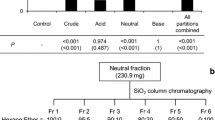Abstract
Cuticular aphrodisiacs fromD. melanogaster females were further characterized and the male response specificity towards such natural and synthetic unsaturated hydrocarbons was investigated. The behavioral activity seems to be correlated with some chain-length requirement and double-bond position; at least one double bond in position 7 seems necessary. This position is more abundant among natural monoenes, and among dienes which also bear a second double bond in position 11, whatever the chain length. Bioassays of the synthetic (Z,Z)-7,11-heptacosadiene yielded a dose-response curve close to that of the natural mixture of heptacosadienes in which the 7–11 isomer is predominant. This female specific 7,11 heptacosadiene appears to be the most potent aphrodisiac for males of the species. Its threshold is lower than that of both 7,11-nonacosadiene and 7-pentacosene which might also play a role in sex and species recognition.
Similar content being viewed by others
References
Antony, C. andJallon, J.-M. 1982. The chemical basis for sex recognition inDrosophila melanogaster.J. Insect Physiol. 28:873–880.
Butterworth, F.M. 1969. Lipids ofDrosophila: A newly detected lipid in the male.Science 163:1356–1357.
Carlson, D.A., Doolittle, R.E., Beroza, M., Rogoff, W.W., andGretz, G. 1974. Muscalure and related compounds. I Response of house flies in olfactometer and pseudo-fly tests.J. Agric. Food. Chem. 22:194–197.
Ehrman, L. 1978. Sexual behavior, pp. 127–180,in M. Ashburner & T.R.F. Wright, (eds.). The Genetics and Biology ofDrosophila, vol. 2b. Academic Press, New York.
Hall, J.C. 1978. Courtship among males due to male sterile mutation inDrosophila melanogaster.Behav. Genet. 8:125–141.
Howard, R.W., andBlomquist, G.J. 1982. Chemical ecology and biochemistry of insect hydrocarbons.Annu. Rev. Entomol. 27:149–172.
Jallon, J.-M. 1984. A few chemical words exchanged by drosophiles during courtship.Behav. Genet. 14:441–478.
Jallon, J.-M., andHotta, Y. 1979. Genetic and behavioral studies of female sex-appeal inDrosophila.Behav. Genet. 8:487–502.
Jallon, J.-M., Antony, C., andBenamar, O. 1981. Un anti-aphrodisiaque produit par les mâles de Drosophile et transféré aux femelles lors de la copulation.C.R. Acad. Sci. Paris 292:1147–1149.
Jallon, J.-M., Benamar, O., Luyten, I., andAntony, C. 1982. Modulations de la production des hydrocarbures cuticulaires aphrodisiaques des Drosophiles résultant de perturbations géné tiques et physiologiques.Colloq. INRA 7:297–302.
Luyten, I. 1982. Variations intraspécifiques et interspécifiques des hydrocarbures cuticulaires chezDrosophila simulons.C.R. Acad. Sci. Paris 295:723–736.
Luyten, I. 1983. Variations intra- et interspécifiques des hydrocarbures cuticulaires et des interactions comportementales chez quatre espèces affines du sous-groupe melanogaster. Thèse de spécialité, Université de Paris VII.
Pechine, J.M., Perez, F., Antony, C., andJallon, J.-M. 1985. A further characterization ofDrosophila cuticular hydrocarbons using a simple method to localize double bonds.Anal. Biochem. 145:177–182.
Tompkins, L., Hall, J.C., andHall, L. 1980. Courtship-stimulating volatile compounds from normal and mutantDrosophila.J. Insect Physiol. 26:689–697.
Tompkins, L., Gross, A.C., Hall, J.C., Gailey, D.A., andSiegel, R.W. 1982. The role of female movement in the sexual behavior ofDrosophila melanogaster.Behav. Genet. 12:295–307.
Venard, R., andJallon, J.-M. 1980. Evidence for an aphrodisiac pheromone of femaleDrosophila.Experientia 36:211–212.
Author information
Authors and Affiliations
Rights and permissions
About this article
Cite this article
Antony, C., Davis, T.L., Carlson, D.A. et al. Compared behavioral responses of maleDrosophila melanogaster (Canton S) to natural and synthetic aphrodisiacs. J Chem Ecol 11, 1617–1629 (1985). https://doi.org/10.1007/BF01012116
Received:
Accepted:
Issue Date:
DOI: https://doi.org/10.1007/BF01012116




